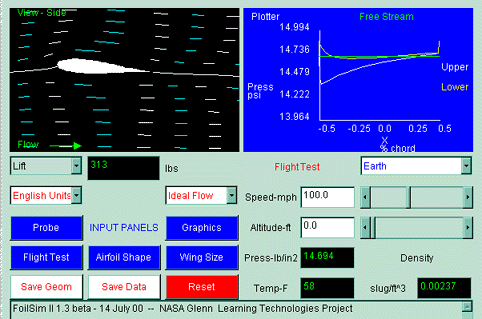
|
The Lift
Equation
|

|
|
Subject Area(s):
|
Algebra I
|
Grade
Level:
|
9-10
|
|
National Mathematics
Standards:
National Technology Standards:
|
Mathematics as Problem Solving:
Students will be able to use, with increasing
confidence, problem-solving approaches to investigate and
understand mathematical content.
Mathematics as Communication:
Students will be able to express mathematical
ideas orally and in writing.
Mathematics as Reasoning:
Students will be able to make and test
conjectures.
Algebra:
Students will be able to use tables and graphs
as tools to interpret expressions, equations, and
inequalities.
Technology research tools:
Use content-specific tools, software and
simulations (e.g., environmental probes, graphing
calculators, exploratory environments, Web tools) to
support learning and research; select and use appropriate
tools and technology resources to accomplish a variety of
tasks and solve problems.
Problem-Solving and Decision-Making Tools:
Routinely and efficiently use on-line
information resources to meet needs for collaboration,
research, publications, communications, and productivity.
|
|
Objective(s):
|
After reading the explanation given below, use FoilSim to
complete the activity. You will solve a multivariable
equation for each of the variables and apply the results to
various problems in different situations.
|
FoilSim is an interactive
simulation software package that examines the airflow around various shapes
of airfoils. As you change parameters such as airspeed, altitude, angle
of attack, thickness and curvature of the airfoil, and size of the wing
area, the software calculates the lift. The package was created at the NASA
Glenn Research Center.
FoilSim II is a Java applet program that executes inside the browser of your computer.
It is available on the World Wide Web at
http://www.grc.nasa.gov/WWW/K-12/airplane/foil2.html.
You can also
download the program to run off-line.
Shown below is a screen
shot from the program's controls and displays. You may change the values
of the variables by using the slider or the input box on the left of the
slider.
To use the slider:
- Click the mouse
pointer on the arrows at the ends of the slider.
- Click the mouse
pointer anywhere between the slider and the arrow.
- Drag the slider
with the mouse.
To use the input
box:
Simply select the
value in the input box, key in the new value, and press Enter or Tab when
finished. The button on the slider will move corresponding to the value
typed in the box.

To begin the problem, click on Investigating
the Lift Equation.
|
Assessment:
|
You, or you and your partner(s), will be evaluated on the
accuracyor feasibility of your answers and your ability to
explain how you arrived at your decisions.
|
|
Evaluation:
|
You will demonstrate the ability to use information found
on the World Wide Web and in FoilSim to complete the
activities and discuss your findings.
|
|
Submitted by:
|
Paula L. Phillips, North Olmsted High School, North
Olmsted, Ohio
|
|
